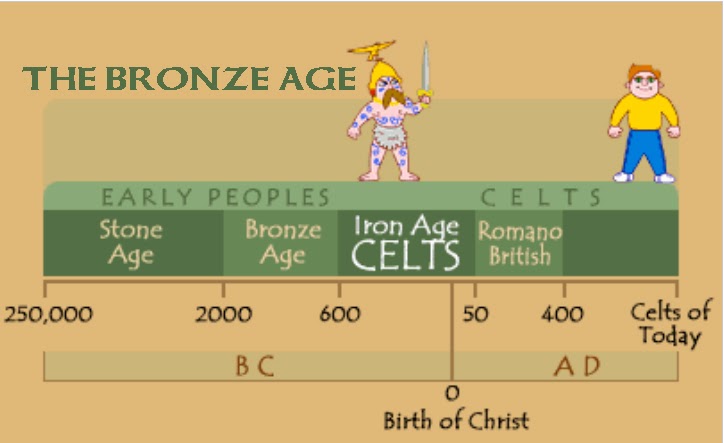Artefacts of The Bronze Age
Finds of
Bronze-age weapons include daggers,
halberds, spearheads and flat
axes. These axe heads
were sometimes decorated spirals or zigzagging
and
have been as far away as Britain and Scandinavia.
The axes are
heavy and this is an indication that
copper was in good supply in
Ireland.
The
grave goods include well made stone battle axes,
metal daggers with elaborately decorated hilts, and
metal daggers with elaborately decorated hilts, and
precious ornaments of gold and amber
- these are
some of the loveliest prehistoric objects ever to be
found in Britain. Among the golden cups found in the
graves, some
were found that were so like those of
the Mycenae that they are used
as examples to prove
the existence of trade between Wessex and
Greece.
Task 1 : Watch this video and describe how 'Smelting' works
Task 2 : Draw and Title the artefacts images that you find on the above link
Task 3 : Using the above link, look at the 'Metalworking' and list the artefacts that are mentioned
The
use of the first bronze tools was an important
moment. Bronze has to be made by heating the
moment. Bronze has to be made by heating the
copper until it is liquid and adding tin. The
molten
bronze can then be cast into a wider range of shapes
than is
possible by flaking flint or grinding stone.
Bronze is also very hard
and long lasting. Controlling
where copper and tin were mined, or
controlling who
got bronze tools, could be an important way to gain
wealth and power. There
were some new artefacts in
this period. New kinds of pottery were
added to
existing types, such as Food Vessels and Collared
Urns. A
new kind of flint tool was the flint dagger,
copying the shape of
early bronze daggers. The main
change was the use of bronze tools.
These included
axeheads, knives, daggers, spears, razors and
jewellery.
Food
Vessels are pots with a flat base, a complex and
highly decorated rim
with a flat edge sloping inwards.
They sometime have lugs
which make them look as
though they could have been hung by string
from a
roof beam or over a fire.
Collared
Urns have a flat, narrow base that expand
upwards to a wide rim that
has a thick, decorated
collar. Used as cremation urns.
Metalworking,
introduced into Ireland about 4,000
years ago, involves the
technologies of prospecting,
mining, smelting, manufacturing and
decorating. The
first metal objects were made from native copper. It
would later be mixed with tin imported from
Cornwall, to make bronze,
a harder metal than pure
copper. Magnificent artefacts would also be
made
from native gold.







No comments:
Post a Comment